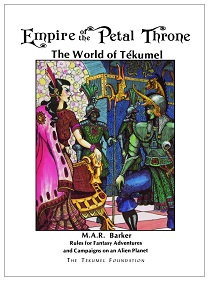I started to feel that I didn’t know roleplaying games well enough so I came up with the plan to read a roleplaying game corebook for every year they have been published. Selection criteria is whatever I find interesting.

Empire of the Petal Throne is the world’s second roleplaying game, if Dungeons & Dragons is the first. It was first published as a manuscript edition in 1974, the same year D&D came out, and then in 1975 as a proper boxed set with maps and everything.
I’ve noticed a phenomenon where a roleplayer decides to explore the early days of the artform, just like I’m doing now. They read Chainmail, are confused by D&D’s first edition and fall in love with Empire of the Petal Throne.
This happened to me too. There’s simply something beautiful about it.
Empire of the Petal Throne holds the distinction of being the first roleplaying game with a proper campaign world, the world of Tékumel. It’s not content to be a generic fantasy roleplaying game but strikes out to make a unique artistic statement. Perhaps because of this vision, its strengths still shine through despite the archaic nature of its design.
The game’s designer M.A.R. Barker is a Tolkien-like figure, a university professor and scholar of ancient languages who invented the world of Tékumel long before the roleplaying game came to be. Like all good designers of fantasy worlds, Barker came up with invented languages which feature prominently in the game. At first, they make the game seem foreboding and difficult to grasp but you get used to their rhythms surprisingly quickly.
In a comment at the end of the game book, Barker says that a key part of his motivation for making the game was that he felt traditional fantasy worlds were boring. Why not have something inspired by the other cultures of the world beyond the European ones?
So what’s the story of Empire of the Petal Throne? What do you do?
The world is a science fiction / fantasy hybrid, a future where humanity has colonized an alien planet which has then suffered civilizational collapse. Because of this, there are humans as well as alien monsters and sentient beings. The great cities of the world have vast dungeons under them from earlier ages. In terms of style, the layered history of Tékumel brings to mind Medieval Arabia or India.
At the start of the game, the characters are foreigners who have just arrived at the city of Jákall. Because the local people are super racist, the characters are forced to do menial tasks, undertake dangerous missions and otherwise do things the locals don’t really want to do.
As their fortune and power grows, the characters become grudgingly accepted into local society, eventually building strongholds and amassing retinues.
The basic structure of the game where the characters explore dungeons, grow powerful and start constructing something is familiar from D&D but this time there’s a cultural context around it. There’s a lot of interesting worldbuilding as the game sets out rules for inheritance and even taxation (1% of character assets per month).
As a published game, Empire of the Petal Throne is complete in a way D&D is not. It provides a good picture of what you’re supposed to be doing, explains the mechanics of play well and even has an example dialogue between the players and the Referee!
As a side note, the game also features what I’m pretty sure is the first LGBT character in roleplaying games, Mnekshétra, the “Lesbian Mistress of Queen Nayári”.
Looking back at the history of roleplaying games, the position of D&D is unassailable. It’s the first roleplaying game. However, there’s something in the artistic vision of Empire of the Petal Throne which makes it seem much more compelling as a precursor to the kind of games we do now.
One thought on “A Game Per Year: Empire of the Petal Throne (1975)”
Comments are closed.